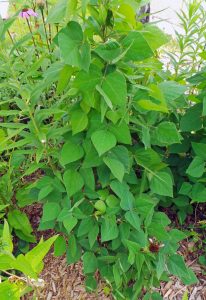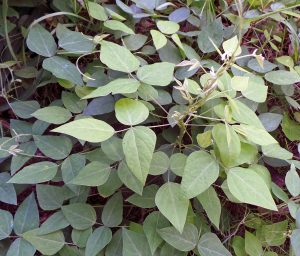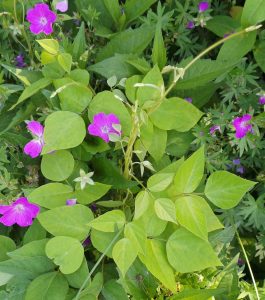
American hog-peanut or hog peanut, Amphicarpaea bracteata, is a vining herbaceous annual plant in the pea family (Fabaceae) native to eastern North America from Manitoba east to Nova Scotia, south to Florida, west to Texas, and north to North Dakota and Montana. It is somewhat unusual because it produces two different types of flowers and seeds – and the genus name refers to that (Greek amphi (of both kinds) and carpos (fruit). The common name comes from the underground fruits, or “peanuts”, that are dug up and eaten by wild pigs.

It is found in moist woods, meadows and prairies but can invade similar types of ornamental landscapes. This plant is often considered a weed when growing in cultivated places. It is a larval host for silver-spotted skipper and northern cloudywing butterflies.
This plant grows from a seed, producing a twining, branched stem that can grow up to 5 feet long during the growing season from a slender tap root. Without tendrils, it climbs by coiling the apical portion of the stem around other plant stems.

The alternate, trifoliate leaves are attached to the thin, smooth to very hairy stem on a long petiole with stipules at its base. The three broadly oval leaflets are often asymmetrical at the base and the petiolule of the center leaflet is much longer than those of the lateral leaflets. The leaves may turn gold or yellow in the fall.

American hog-peanut produces two types of flowers. The flowers on the upper branches look like typical pea flowers, hanging in loose pendant clusters (racemes) from leaf axils in August and September. The flowers are about ½ inch long with four slightly asymmetric fused pale green sepals. The five elongate petals may be white, pale pink, lilac or pale purple. The flowers open before fertilization and are usually cross-pollinated (chasmogamy).

The flowers are followed by flat, oblong spotted pods that are pointed at both ends and usually contain three or four seeds. The seeds are ballistically dispersed and can be cooked to be eaten and used in the same ways as lentils.


The flowers that occur on the lower, lateral branches are inconspicuous, lack petals and do not open (the term for flowers that are self-fertilized without opening is cleistogamous). The ground level stolons search for crevices in the soil where they produce the flowers that rest on or under the ground. These are followed by a single-seeded fleshy pod that buries itself just below the soil surface in a manner similar to peanuts (Arachis hypogaea, although it is not closely related to that plant). These underground fruits are edible and can be eaten raw or boiled to remove the hulls and the seed eaten like a nut. Many Native American people would they collect this “peanut” that can be up to ½ inch in diameter from the ground around the plant as a minor food source.

American hog-peanut grows well in most light conditions from full sun to full shade in moist soils of any type, and is typically found in and on the edge of woodlands, wet meadows and prairie, and in disturbed sites such as in gardens with dappled shade or along trails, roadsides and forest edges. It has occasionally been cultivated as a peanut substitute but yields are rather low. Nodules formed by certain strains of Rhizobium bacteria on the roots fix atmospheric nitrogen which is utilized by the growing plant and by other plants growing nearby. To control where the plants are not wanted, pull repeatedly, several times a year for several years. Because they tend to be mixed in with other plants, chemicals may be difficult to use without damaging other plants unless all vegetation is to be removed.
– Susan Mahr, University of Wisconsin – Madison
Ask Your Gardening Question
If you’re unable to find the information you need, please submit your gardening question here:





 Marigolds
Marigolds Create a Butterfly Garden
Create a Butterfly Garden Plant Flowers to Encourage Beneficial Insects
Plant Flowers to Encourage Beneficial Insects Forcing Bulbs
Forcing Bulbs


